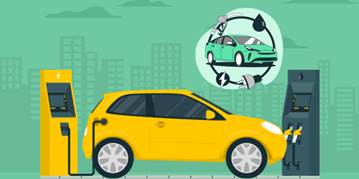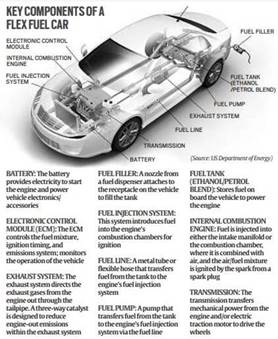Description

Disclaimer: Copyright infringement not intended.
Context
- Union Minister for Road Transport and Highways Shri Nitin Gadkari Launched Toyota’s first of its kind pilot project on Flexi-Fuel Strong Hybrid Electric Vehicles (FFV-SHEV) in India.
Flex Fuel Vehicle
- A flex fuel, or flexible-fuel vehicle (FFV) has an internal combustion engine (ICE),but unlike a regular petrol or diesel vehicle, this can run on more than one type of fuel, or even a mixture of fuels. Flex fuel vehicles (FFV) are capable of running on 100 per cent petrol or 100 per cent bio-ethanol or a combination of both.
- The most common versions use a blend of petrol and ethanol or methanol,but these engines are also equipped to run on 100 per cent petrol or ethanol as well. Both fuels are stored in the same common tank.
- Flex-fuel vehicles are distinguished from bi-fuel vehicles, where two fuels are stored in separate tanks and the engine runs on one fuel at a time, for example, compressed natural gas (CNG), liquefied petroleum gas (LPG), or hydrogen.
- The most common commercially available FFV in the world market is the ethanol flexible-fuel vehicle.

Flex Fuel Benefits
- Cheaper Oil Alternative.Oil is a finite resource so it is necessary to find an alternative or a way to reduce its usage. The flex fuel is a gasoline alternative that is ready for mass commercial use. Mixing up gasoline with ethanol definitely expands the world’s oil supply.
- Steady Supply of Raw Materials.Ethanol is made from either sugarcane or corn – both crops are cheap and mass-produced. Except for the possibility of increased costs of corn for food production, the supply of the raw materials for flex fuel is steady.
- Natural Anti-freeze.Ethanol is a natural anti-freeze, so it prevents the gas lines from freezing during the chilly winter.
- Less Carbon Footprint. Ethanol burns cleaner than gasoline, emitting much lower greenhouse gases and carcinogen benzene than petroleum oil. It is water-soluble, non-toxic, and biodegradable. Use of ethanol blending sharply lowers harmful pollutants such as carbon monoxide, sulphur, and carbon and nitrogen oxides.
- Cost-efficient.Each gallon of flex fuel costs less than per gallon of gasoline.
- Burning facility:Possibly the greatest advantage is that the flex fuel vehicle has been designed to burn whatever proportion of mixture is in its combustion chamber. Electronic sensors gauge the blend, while microprocessors adjust the fuel injection and timing.
- Alternative to oil:Many flex fuel vehicles make use of ethanol, which originates from corn and sugar cane, a viable alternative to purchasing foreign oil.
- Sustainably produced: Many Flex fuel vehicles run on ethanol. This is sustainably produced from ingredients such as cane sugar and corn. This makes ethanol a good alternative to purchasing foreign oil.
- Import Dependency:It will help in deleveraging the country’s dependence on imported fossil fuels for transportation.
- Similar Performance:CNG-fueled cars are known to produce less power than their petrol counterparts. This is not the case with flex-fuel cars as they still use some petrol in the fuel, which provides similar, and sometimes better, performance than pure petrol cars.
In a nutshell,
- FFV Technology (Vehicle can run on either 100% diesel or DME-Diesel mode)
- The transition of diesel trucks from conventional diesel to DME as an alternative fuel (First phase as FFV; Second Phase as dedicated 100% DME/alternative fuelled vehicle)
- Less / negligible smoke/soot/particulate matter (PM) emission
- Lower noise with smoother engine/vehicle operation
- Improvement in transient engine performance
- Enhancement of energy security
- Sustainable environment as there is a substantial reduction in GHG emissions.
The cons of Flex fuel
- Not Quite Eco-Friendly:Ethanol yields fewer greenhouse gases but it produces more smoke-causing chemicals than petroleum oil. Many ethanol plants also use coal instead of natural gas as their primary energy source, which is not good for the environment.
- May Cause Corrosion:Being a type of alcohol, ethanol breaks down faster than gasoline and attracts water. As it causes water absorption into the fuel, it may lead to the forming of rust in different engine parts. Plus, the rust particles can clog the fuel filter.
- Engine Damage:Ethanol can also unfortunately cause corrosion and damage to the engine, mainly because it absorbs dirt easily.
- Expense: Ethanol is also not as economical as gasoline; in that it does not provide the same level of fuel efficiency.
- Possible Increase in Food Prices:The two chief raw materials for ethanol production are corn and sugarcane – both of which are food crops. Using them for the mass production of flex fuel may increase their prices as human and animal food products. Plus, a big-scale cultivation will take a huge amount of land that can otherwise be used for different purposes.
- Fuel Economy: A flex fuel car typically takes a small hit on fuel efficiency when using ethanol for motive power, ranging from between 4 per cent and 8 per cent. So, fuel economy is generally lower with increased levels of ethanol (engines are optimised for petrol). But on the flip side, many flex fuel vehicles have improved acceleration performance when operating on higher ethanol blends.
- Water Intensive:A major problem with ethanol blending is that crops such as sugarcane are usually very water-intensive. A NITI Aayog report suggested that in 2019-20, of the total ethanol produced in the country, over 90 per cent came from sugarcane alone.
- Pricier Vehicles:Higher blending of ethanol will mean higher manufacturing costs which translates to pricier vehicles. Certain auto parts, especially those that come in contact with higher ethanol content, will have to be replaced with a compatible product to avoid corrosion.
Why is government of India pushing for FFVs?
- Last year (FY21), India’s oil import bill stood at $62.7 billion which was matched in just the first seven months (April-October) of this year.
- To make matters worse, the rupee is at its weakest level in last three financial years. The government is desperate to bring down the oil import bill by creating fuel substitutes like ethanol, hydrogen and electricity.
- Even a push till the E20 level (petrol blended with 20 per cent ethanol) can result in savings of $4 billion per annum, as per estimates.
- A per, Ministry of Petroleum and Natural Gas, by just hitting E20, carbon monoxide emissions were observed to be 50 per cent lower in two-wheelers and 30 per cent lower in four-wheelers compared to petrol.
Way Ahead
- During a time when the country imports most of its fuel from other nations, inclusion of flex fuel engines will be a boon for the country’s economy. Furthermore, usage of flex fuel will also give the country more grip in completing its goals for reducing the carbon footprint.
- More ethanol refining plants need to be developed.
- There can be a government subsidy to narrow the price gap of higher ethanol blends, just to make the proposition viable. That is another factor that would have to be considered as India steps up its fuel blending plan.
|
Case Study
In Brazil, nearly all cars are required to be equipped to handle fuel blends with a minimum of 22 per cent ethanol. As a result, across most cities in Brazil, practically no light vehicles run on pure petrol. There is also a government subsidy to narrow the price gap of higher ethanol blends.
|
https://pib.gov.in/PressReleasePage.aspx?PRID=1866786
















